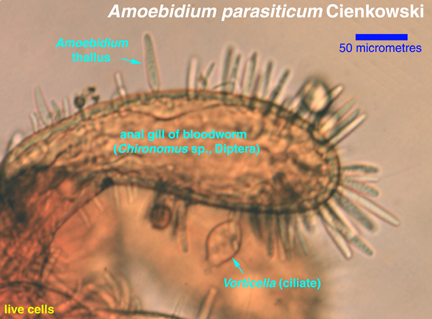
Amoebidium species occur in freshwater environments, only as epibionts on the cuticle of insect larvae and small crustaceans. The trophic ("vegetative") state is an elongate, walled hairlike thallus, which during asexual reproduction may cleave into naked amoeboid cells or walled sporangiospores.

|
The thalli are usually colorless, slightly tapered cylinders that are attached to the host cuticle by a narrow holdfast. Until reproduction occurs, the thalli lack partitions (they are "unicellular"). All but the smallest thalli, however, contain more than one nucleus. |
Amoebidium: Index | Introduction | Appearance | Ultrastructure | Reproduction and Life History | Similar genera | Classification | Taxonomy and Nomenclature | Cultures | References | Internet resources
Protist Image Data: Picture Gallery | Home Page